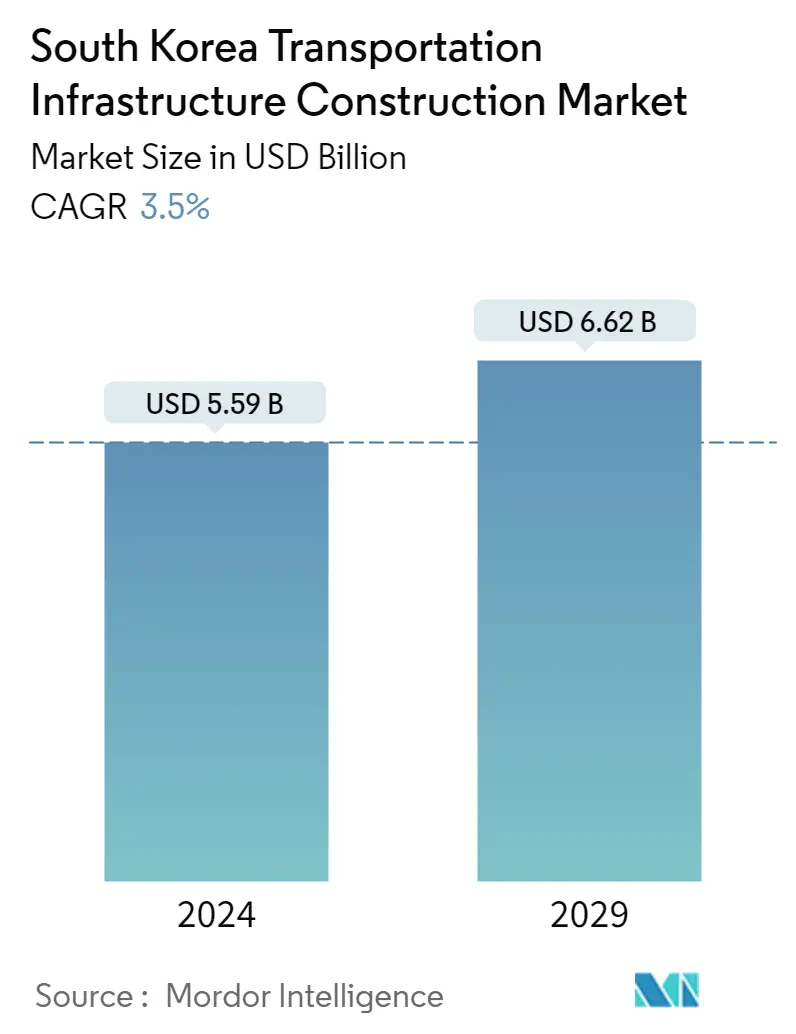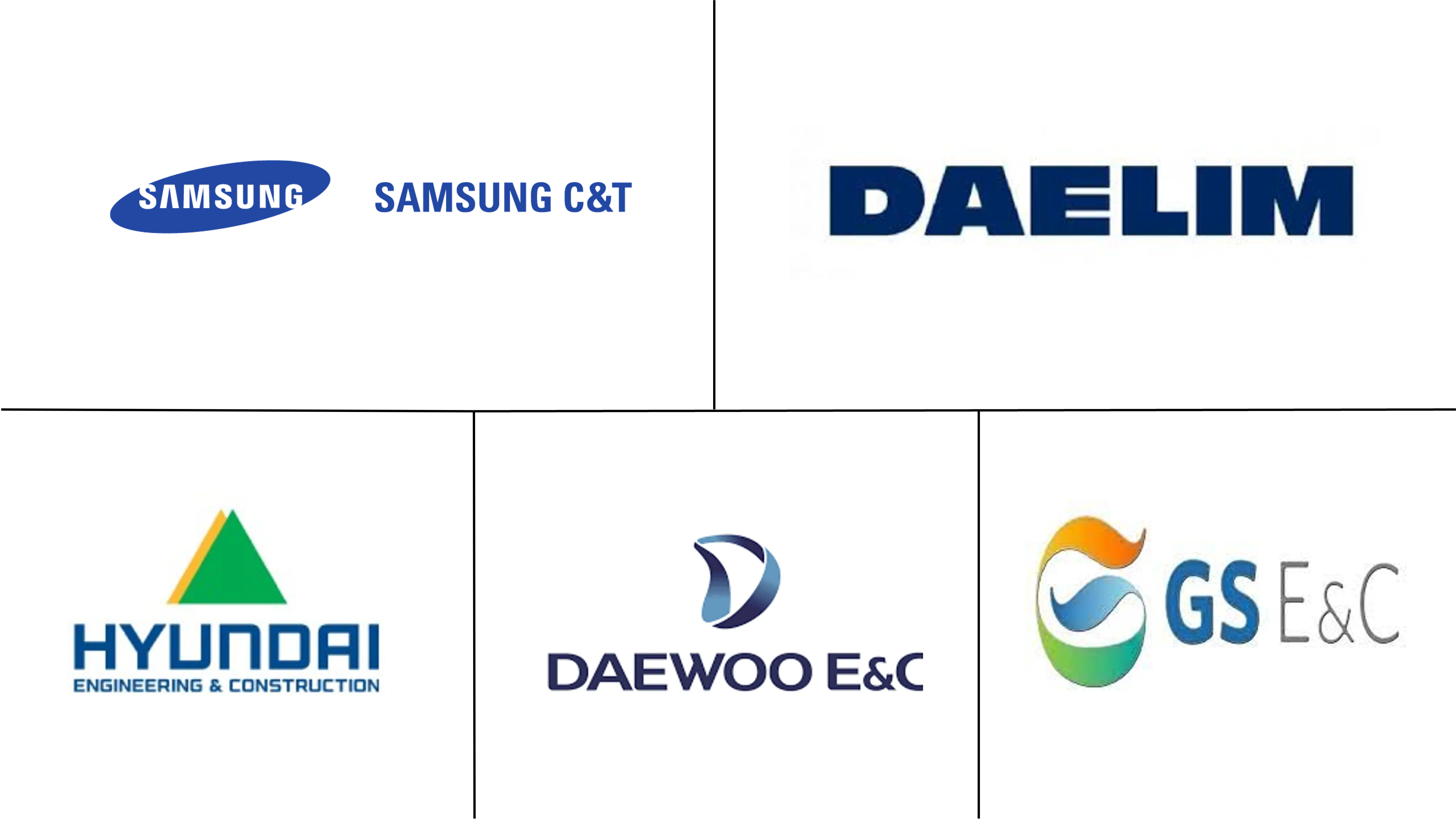Market Size of South Korea Transportation Infrastructure Construction Industry

| Study Period | 2019 - 2029 |
| Market Size (2024) | USD 5.59 Billion |
| Market Size (2029) | USD 6.62 Billion |
| CAGR (2024 - 2029) | 3.50 % |
| Fastest Growing Market | Asia Pacific |
| Largest Market | North America |
Major Players
*Disclaimer: Major Players sorted in no particular order |
South Korea Transportation Infrastructure Construction Market Analysis
The South Korea Transportation Infrastructure Construction Market size is estimated at USD 5.59 billion in 2024, and is expected to reach USD 6.62 billion by 2029, growing at a CAGR of 3.5% during the forecast period (2024-2029).
- Due to COVID-19 lockdowns and labor unavailability, the transport infrastructure construction market took a hit. Many construction projects were stopped to ensure the safety of the workers. The supply chains, plants, equipment, and manpower were hugely impacted. Now, the sector is recovering and focusing on developments.
- The government has been enhancing equity in land use and publicness through road projects such as the Gwangmyeong-Seoul Expressway, which started construction in 2019, and the Jecheon-Yeongwol Expressway, which passed a preliminary feasibility study last year. Increased efficiency.
- According to the situation in which 96.5% of the current transport sector's greenhouse gas emissions are generated on roads, a reduction effect can be expected through the operation of exclusive lanes for trucks and the construction of ICs for trucks.
- In particular, in response to the rapid demographic change in Korean society and the demand for easing the disparity in the extinction region and congestion in the metropolitan area due to overcrowding in the metropolitan area, the low-carbon road logistics system, digital road asset maintenance, wide area transportation network maintenance, and three-dimensional road project are necessary.
- MOLIT will accelerate key transportation projects such as the Great Train eXpress (GTX), high-speed railways, underground expressways, and the new airport in Gadeokdo to solve traffic congestion issues in metropolises and achieve more balanced national growth. To provide consumer-centric services, public transportation will make an innovative shift. MOLIT intends to increase investment in expanding public transportation services and improving intermodal transfer while updating outdated regulations. Efforts will also be made to improve transportation accessibility for vulnerable groups such as disabled people, older people, and those living in remote areas. The transportation industry is currently undergoing a period of rapid mobility transformation in South Korea.
South Korea Transportation Infrastructure Construction Industry Segmentation
The transport infrastructure construction market includes many activities associated with the construction of roads, railways, airports, and other related infrastructure.
The South Korean transportation infrastructure construction market is segmented by type (roadways, railways, airports, ports, and inland waterways).
The report offers market size and forecasts for the transportation infrastructure construction market in value (USD) for all the above segments.
| By Mode | |
| Roadways | |
| Railways | |
| Airways | |
| Ports and Inland Waterways |
South Korea Transportation Infrastructure Construction Market Size Summary
The South Korean transportation infrastructure construction market is poised for steady growth over the forecast period, driven by significant government investments and strategic projects aimed at enhancing mobility and reducing congestion. The sector is recovering from the setbacks caused by COVID-19, which had disrupted supply chains and halted many projects. The government is focusing on developing road projects like the Gwangmyeong-Seoul and Jecheon-Yeongwol expressways to improve land use equity and efficiency. Additionally, initiatives such as the Great Train eXpress, high-speed railways, and the new airport in Gadeokdo are being accelerated to address urban congestion and promote balanced national growth. The market is characterized by a mix of national and international players, with companies like Samsung C&T, Hyundai E&C, and Daewoo E&C playing pivotal roles.
The industry is also witnessing a transformation towards smart and sustainable infrastructure, with efforts to integrate digital technologies and low-carbon solutions. The Korea Expressway Corporation is developing smart roads and solar highways, while KORAIL is advancing the 'Korea Railroad New Deal' to enhance digital, green, and regional balance initiatives. The market's fragmentation offers opportunities for new entrants, supported by ongoing projects and international collaborations, such as the agreement with Poland to develop transport infrastructure in Europe. Furthermore, South Korean logistics firms are expanding their global presence, as seen in CJ Logistics' investment in North America, to cater to increasing export volumes. These developments underscore the dynamic nature of the South Korean transportation infrastructure construction market, with a focus on innovation and strategic growth.
South Korea Transportation Infrastructure Construction Market Size - Table of Contents
-
1. MARKET INSIGHTS
-
1.1 Market Overview
-
1.2 Market Dynamics
-
1.2.1 Drivers
-
1.2.1.1 High dependency on transportation
-
1.2.1.2 Increasing cross border trade
-
-
1.2.2 Restraints
-
1.2.2.1 Lack of investments in infrastructure projects
-
1.2.2.2 Shortage of skilled labor
-
-
1.2.3 Opportunities
-
1.2.3.1 Increasing demand for public transportation
-
1.2.3.2 Country's strategic location as a gateway to Asia
-
-
-
1.3 Value Chain / Supply Chain Analysis
-
1.4 Industry Policies and Regulations
-
1.5 Technological Developments in the Sector
-
1.6 Industry Attractiveness - Porter's Five Forces Analysis
-
1.6.1 Bargaining Power of Suppliers
-
1.6.2 Bargaining Power of Buyers
-
1.6.3 Threat of New Entrants
-
1.6.4 Threat of Substitutes
-
1.6.5 Intensity of Competitive Rivalry
-
-
1.7 Impact of COVID-19 on the Market
-
-
2. MARKET SEGMENTATION
-
2.1 By Mode
-
2.1.1 Roadways
-
2.1.2 Railways
-
2.1.3 Airways
-
2.1.4 Ports and Inland Waterways
-
-
South Korea Transportation Infrastructure Construction Market Size FAQs
How big is the South Korea Transportation Infrastructure Construction Market?
The South Korea Transportation Infrastructure Construction Market size is expected to reach USD 5.59 billion in 2024 and grow at a CAGR of 3.5% to reach USD 6.62 billion by 2029.
What is the current South Korea Transportation Infrastructure Construction Market size?
In 2024, the South Korea Transportation Infrastructure Construction Market size is expected to reach USD 5.59 billion.

